Take The "A" Train
- Kinda Dukish
- Videography
- Radio Hawkins

Thursday, January 17, 2013
Far of the middle: ellington's 1963 state department tour.



- Duke Ellington's Far East Suite : Liner notes for the original CD reissue in 1988 By Neil Tesser
- Satchmo Blows Up the World: Jazz Ambassadors Play the Cold War by Penny M. Von Eschen (Harvard University Press, 2006)
- Duke Ellington's America by Harvey Cohen (University of Chicago Press, 2011)
17 comments:
Hi Ehsan What an interesting and beautiful posting! And the nice photos you found to go with this!

Coincidentally - and completely parochially - I posted about Duke appearing on the cover of TV Times of all things at my blog today - from 8 February, 1963! Like all of Ellington's years, reflecting on the fiftieth anniversary of 1963 is a rich experience. Your posting here is wonderful and I shall link to it for my own future reference. Many thanks, Ehsan!
Thanks Ian, I just went to your venue and saw the post you've mentioned. Here I have an idea for a thriller/musical/adventure film: instead of all those stupid films Hollywood makes about Iran (Argo included), my story is about an Ellington freak who illegally travels to the revolutionary Iran to find the holy grail - the footage of November 5th TV broadcast from Tehran! The soundtrack of the film is, obviously, Ellington. No happy ending is welcomed. Should work on that more!
Great work, Ehsan!
Dear Ehsan, I'm writing a play that is set around Ellington's tour to Iran in 1963. Your blog is a great centralization of the various pieces of information that exist on the subject. Do you know the venue of the Tehran concert? Kheyli mamnoon! Torange
Dear Torange, I have no specific information about the place for the Tehran concert, but I'd say, most likely, Amdjadieh must have been the venue and I'm saying this because of the known fact about similar "western" visits to the city. Most of the post-1967 concert were held in the more prestigious and glamorous Roudaki Hall which I have a nice story about it here, blogged by my uncle: http://ehsankhoshbakht.blogspot.com/2013/03/PB.html Would you kindly give me more information about your play? Possibly sending it to my private email which you can reach on "about me" section of this blog? Ghorbanat! Ehsan
Torange, see this too: http://en.wikipedia.org/wiki/Shahid_Shiroudi_Stadium
Simply brilliant and informative. Thank you from Kabul.
Hi there, Very interesting read. I was wondering whether Duke played in Ankara or not since you've mentioned in your post that "Duke was forced to cancel the remaining of the tour in Istanbul, Nicosia, Cairo, Alexandria, Athens, and Thessaloniki". If these were the "remaining dates" then he'd played Ankara concert. Could you, if possible, please clarify this for me? thank you..
No concert in Ankara or any other city in Turkey, because only one day after arrival of the band, the news of Kennedy's assassination broke.
thanks for the fast reply and the additional information. I've already posted a tweet inc. the link to this page. hope it'll draw some attention to this interesting story, it deserves appreciation. greetings from Ankara. bye.
Hello Ehsan! This is an amazing post with wonderful photos and detail. I produce a blog for the Southern California NPR station 89.9 KCRW and referenced your blog outlined this tour and linked out to it in one of our posts. Really like your blog and look forward to reading more of it! http://blogs.kcrw.com/rhythmplanet/?p=8975
Mary, many thanks for your kind remarks, also for putting a link to this post on your website.
interesting information .. thanks
Hey this post is great. For me "The far east suite" is awesome. In this suite there are a track that amazes me. Is "Isfahan in my opinion isthe rithym that they do is almost rock. The strength of tis track is incredible.
Are you really love to seen the best travel spots where you think yourself free and discovered person see this Here is one important application Macau Day Trip which can be installed in the smartphone or any other gadget at ease. There are better options and all new facilities coming up in the market with time which Macau alphard van is changing the whole user experience. If you are tool travelling to any destination try out these all new application that can help you to save a good amount of money.

When Duke Ellington Played The Middle East
Back in 2011, I wrote a post about American jazz diplomacy during the Cold War, a fascinating piece of jazz history– click here to read it. Jazz has always been America’s unique cultural gift to the world, though some might say that it’s been supplanted by hip hop.
And now my old friend Alan Geik, who once co-hosted a popular tropical Latin music show on KCRW, sends me a timely article from the BBC News Magazine which is really fascinating. The article is about when Duke Ellington performed in Kabul, Afghanistan in 1963. It was a different time for the country and the city. Duke Ellington’s sound was new to people and as described in the article, people were awed by the performance.

People now may forget the Kabul concert and the Middle Eastern Tour. The US State Department had sent Duke Ellington and His Orchestra over for a Middle East Tour as a US public relations effort–“Jazz Diplomacy”. In addition to Jazz musicians, other American artists did similar “Good Will” tours”: Orson Welles and Walt Disney went to South America in the 40’s. After Ellington’s tour, the Far East Suite was released in 1967 with music inspired from his travels.

Ehsan Khoshbakht’s Jazz blog has a fantastic detailed outline and photos of the journey.
Hey! Did you enjoy this piece? We can’t do it without you. We are member-supported, so your donation is critical to KCRW's music programming, news reporting, and cultural coverage. Help support the DJs, journalists, and staff of the station you love.
Here's how:
- Sign-up for our newsletters .
- Become a KCRW member .
- Subscribe to our Podcasts .
- Donate to KCRW .
- Download our App .

OUTSIDE LANDS FEST
KCRW’s Summer Special is almost over. Donate today for your chance to win two epic prizes: a box at the Hollywood Bowl to see Natalia Lafourcade and Gustavo Dudamel AND a pair of VIP passes to Outside Lands!
ends sunday
- Environment
- Road to Net Zero
- Art & Design
- Film & TV
- Music & On-stage
- Pop Culture
- Fashion & Beauty
- Home & Garden
- Things to do
- Combat Sports
- Horse Racing
- Beyond the Headlines
- Trending Middle East
- Business Extra
- Culture Bites
- Year of Elections
- Pocketful of Dirhams
- Books of My Life
- Iraq: 20 Years On
9 of the biggest concerts to take place in the Arab world: from Frank Sinatra at the Pyramids to Ella Fitzgerald in Lebanon
They may be gone, but these influential performers left their mark on the region.

American singer Frank Sinatra during his performance in front of the Sphinx in Giza on September 27, 1979, in Cairo, Egypt. AP

It's been almost 42 years since James Brown played his debut concert in the Middle East, an event that would go down in regional music history.
On December 16, 1978, the Godfather of Soul wowed fans with a frenzied and sweaty performance in Kuwait, the first of six sold-out shows in five days, for which he played classics including Papa's Got a Brand New Bag and It's a Man's Man's Man's World.
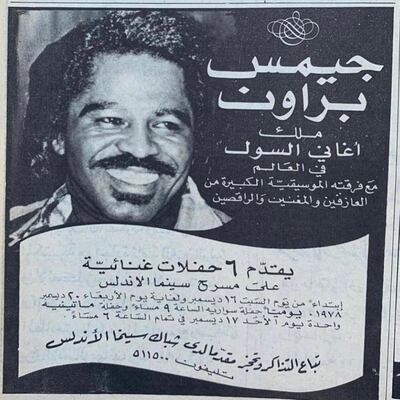
The upcoming anniversary was pointed out on Twitter by Ali Al Saeed, who shared newspaper clippings from the time. Four decades may have passed since Brown took to the stage, but the concert's legacy is still being felt as part of the wider story of the region’s burgeoning history of live performances.
While Brown's sell-out show was one of the biggest of its era, even in the 1970s, the Arab world was used to hosting some of the biggest names in western music.
From jazz great Duke Ellington's 1963 show in the Syrian capital Damascus, to King of Pop Michael Jackson's blockbuster stadium concert in Tunis in 1996, these huge acts left their mark on the Middle East and awakened the US and European music industries to the touring opportunities to be found in the region.
Here are eight classic concerts by late legendary artists that took place in the Arab world …
1. Duke Ellington
Middle East – 1963
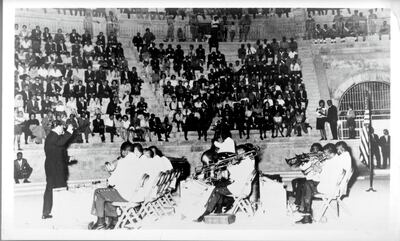
This was a historic tour with US government approval. Supported by the Department of State, legendary composer and pianist Duke Ellington swung through the Middle East and South Asia on a three-month tour that included stops in Syria, Jordan, Afghanistan, India, Sri Lanka, Pakistan, Iran, Iraq, Lebanon and Turkey. Kicking off the tour at the Roman amphitheatre in Amman, Ellington and his orchestra tore through a 16-song set that included Take the A Train , Tutti for Cootie and One More Once .
2. Louis Armstrong
Beirut, Lebanon – 1959
At the peak of his fame, the American trumpeter and jazz singer came to Beirut to perform a run of sold-out shows at the Unesco Theatre on April 6 to April 9, 1959.
The concert was part of a flurry of cultural diplomatic initiatives undertaken by the US government to counter Soviet communist influence.
A copy of the programme is available for private sale online at the Ian Brabner Rare Americana website . The set list is a jazz aficionado's dream with "Satchmo" performing the hits Mack the Knife , St Louis Blues and I Can't Give You Anything But Love .
3. Frank Sinatra
Giza Pyramids, Egypt – 1979
Ol' Blue Eyes graced the stage on September 27, 1979, with a classic set that included Someone to Watch Over Me , I've Got You Under My Skin and Strangers in the Night . Such was the significance of the event, the US press sent along a handful of journalists to document the performance of the "Chairman of the Board", as he was known.
It was reported that Sinatra was his usual charming self on stage and quick with a pun or two. According to The Washington Post, he expressed his amazement of the Pyramids behind him, quipping of his own heritage: "If the Italians had done it, they would never have finished it."
4. Ella Fitzgerald
Baalbeck International Festival, Lebanon – 1971, 1972
On July 17, 1971, the jazz great took to the festival stage for a heart-warming set. Aided by a cracking band, she performed solo and jazz standards such as Night and Day , Body and Soul and I Loves You Porgy to an enraptured crowd.
In the audience that night was Ahmed Kassab, who told BBC Radio programme Outlook the concert was a joyous affair. "The atmosphere was just one of positive energy all around," he said. "There was laughter, smiles, chit chat and pure joy." Fitzgerald enjoyed herself, too, returning to perform at the festival the following year.
5. Miles Davis
Baalbeck International Festival, Lebanon – 1973
The mercurial jazzman is known for his reticent stage presence, but surely even he must have cracked a smile at performing with the stunning Temple of Jupiter as his backdrop. While there is no information on what was played as part of his Baalbeck International Festival gig on July 6, 1973, his European tour had him dropping crowd favourites such as Calypso Frelimo , Right Off and Funk .
6. Ray Charles
Carthage, Tunisia – 1976
With his music out of fashion thanks to the rise of psychedelic rock, soul man Charles took to the road and performed his one and only date in the Arab world. With no album to promote, Charles's July 30, 1976 show was part of a run of greatest-hits gigs that included classics Georgia On My Mind , How Long Has This Been Going On? and What'd I Say
7. Michael Jackson
Tunis, Tunisia – 1996
It is only right that one of the biggest tours in pop music history resulted in one of the region's biggest concert gatherings. More than 60,000 fans crammed into the Stade Olympique d'El Menzah in the Tunisian capital to witness Michael Jackson's ground-breaking HIStory World Tour. Split into five sections, the blockbuster show had state-of-the-art screens, light shows and special effects. And then, of course, there were the classic hits including Smooth Criminal , Billie Jean and Thriller .
Jackson was more than up for the occasion. He released a statement four days before the show in which he underscored the importance of the performance.
"This concert will be of special significance for me because it will be my first in Africa and the Arab World,” he said. “The people and nations of both regions have always held a special place in my heart and I always wanted to perform for them.”
8. Chuck Berry
Dubai – 1998
A dream gig for any rock'n'roll fan: an intimate concert by one of the genre's architects at the Hard Rock Cafe's opening. Held at its original venue in an area that would become Dubai's Media and Internet cities, Hard Rock Cafe remained there until 2011 before relocating to Dubai Festival City. Berry's blistering performance and the original location will go down as one of the UAE's best rock 'n' roll memories.
______________
The 11 best Arab independent musicians you should be listening to right now
9 songs that capture Lebanon's passion and heartache: 'even in your madness I love you'
From Mohammed Assaf to Mashrou’ Leila: 10 Arabic pop songs that defined the decade

Duke Ellington's Far East Suite
Liner notes for the original cd reissue in 1988.
To begin with, it shouldn't be the Far East Suite at all. The 1963 State Department tour that this music commemorates brought Duke Ellington and his famous orchestra to Ceylon (now Sri Lanka), Egypt, India, Iraq, Jordan, Lebanon, Pakistan, Persia (now Iran), and Turkey -- a glorious itinerary of the Near and Middle East, but not a truly Far Eastern city in the lot. Only one of the Suite 's nine sections makes programmatic reference to Japan or China, and that one, "Ad Lib on Nippon," was inspired by the following year's journey to Japan. No matter. Thanks to the artistic license that others have to earn (but that Ellington seems to have been born with), the Far East Suite it was. Despite his fanciful emendation of the world map, though, Ellington's sense of musical geography proved stunningly accurate. Has anyone ever captured a locale so completely -- with music so clearly tethered to the place in question -- and yet remained so much himself? Each segment of the Far East Suite is typically, unmistakably Ellington, using colors, rhythms, melodic contours he had pioneered nearly four decades earlier, buoyed by the familiar, barely reined energy of his close-knit orchestra. Yet at the same time, each segment stands as a brilliant example of musical journalism, conveying the scene and story, the fascinating flavors and unfamiliar aromas, through the sensations of a terrific reporter. Not a daily-dispatch reporter, mind you (although Ellington did come up with an enviably quotable assessment of the military coup that coincided with the band's stay in Baghdad -- "Those cats were swinging, man!" he told newsmen in Beirut a few days later). Rather, Ellington played the essayist, taking in, as he always did, all the sights and sounds available, with the intention of digesting his experiences and translating them into music at some unspecified date. He expressed no interest in copying down this scale or annotating that unusual rhythm: "It's more valuable to have absorbed while there," he wrote in Musical Journal (March 1964). "You let it roll around, undergo a chemical change, and then seep out on paper in the form that will suit the musicians who are going to play it." Ellington was not alone in undergoing this process of creative alchemy: the writing of the entire Far East Suite , with the exception of "Ad Lib on Nippon," is co-credited to the Maestro and Billy Strayhorn, who had been his musical blood-brother for 25 years at the time the Suite was composed. (Strayhorn, who occasionally played piano in Ellington's place, had a busier trip that expected. Where Ellington's curiosity could match the novelty of the Orient, his immune system could not, and he had to miss several concerts.) The same alchemy was at work on key members of the band, too: during the three years between the Mideast tour and this recording, the main soloists -- Johnny Hodges, Paul Gonsalves, and Jimmy Hamilton -- seemed to have distilled their memories of the tour. Throughout this album, they eschew the comfortable musical phrases gathered during a professional lifetime in favor of recapturing the unique experiences that marked their sojourn. Hodges, of course, had well established his importance in the music of Ellington and especially Strayhorn, whose sensuous ballads so movingly exploited his heavy-lidded sound. And by the time of this recording, Gonsalves was very much the primary soloist for the Ellington orchestra. But in some ways, the Far East Suite belongs most to Jimmy Hamilton, the second tenor saxist and clarinet specialist who joined Ellington in 1942 and left the band a year and a half after the Suite was recorded. Ellington had always liked the clarinet as an exotic tonal color, dating back to the days of his Jungle Orchestra; writing his most evocative music since then, he naturally turned to the instrument's reedy mystery (as well as the serpentine harmonies lurking within the clarinet duo of Hamilton and Russell Procope). Two of the suite's movements are designed around Hamilton as the featured soloist, and he remains near the spotlight on the others. Leading the ensemble passages on such difficult tunes as "Depk" and "Amad," Hamilton becomes, by dint of the instrument he played and his own musicality, the straw boss for the Suite . This music also brought the band's new drummer, Rufus "Speedy" Jones, to the forefront; by happy accident, his first recording with the band required plenty of the mysterious, exotic rhythmic propulsion that was in fact his forte. (Ellington himself, in his autobiographical Music Is My Mistress , took note of Jones's contribution to the band's "African, jungle, and oriental pieces.") All things considered, Sam Woodyard may have been the dream Ellington drummer; but not even Woodyard -- who had done the drumming on the State Department tour -- could have driven these pieces with such complex abandon. I can't imagine anyone disputing that this work stands among the best of the Ellington suites -- even though it faces stiff compeititon, from such notable contenders as Black, Brown and Beige , the Perfume Suite , and A Drum Is A Woman (and from less well-known collections like the Goutelas Suite and The River ). The portraits in the Far East Suite display a variety, a range of emotion and expression -- but also an interconnectedness -- that surpass most of the others; there exists no better example of Ellington's genius for transmuting the most personal artistic details into music of universal insight. In addition, there is the extraordinary level of the individual solos, revealing (in Stanley Dance's phrases) "the inspiration of unusual chords." As Ellington wrote in Musical Journal , "The tour was a great adventure for us on what is indeed the other side of the world. Sometimes I felt it was this world upside down. The look of the natural country is so unlike our and the very contours of the earth seem to be so different." Perhaps it is that still palpable sense of wonder and discovery that, some three years after the tour itself, so elevated these performances. But then, I'm a bit biased. The Far East Suite was the first jazz album I purchased, in 1968, back when I was just starting -- no, actually before I'd really begun -- to explore jazz. Three years later, "Mount Harissa" (a movement from the Suite ) became the theme song of my college radio program, as well as the program's name; twenty years later, I ask myself if Paul Gonsalves's surging solo on that tune sounds so ineulctably perfect because of the couple hundred times I've listened to it, or whether it's the other way around. * * * The process of creation is usually messy, and the assemblage of the Far East Suite offers a case in point. Seven of its nine pieces were completed soon after the State Department tour, but the finale came a good deal later, following the orchestra's 1964 tour of Japan. "Mount Harissa," the emotional high point of the work, was probably not written until 1965, and in fact, its first working title suggests that it wasn't originally planned for the Suite at all. But Ellington never threw anything out, and melodies and arrangements from years earlier (as well as from last week) often lay dormant until the proper setting presented itself. Another such example is the voluptuous Strayhorn ballad that eventually gained the title "Isfahan." The best known melody in this collection, "Isfahan" has had a life entirely separate from the Suite . It first appears on a New York studio session from July 1963 (two months before Ellington visited the Middle East), when it undoubtedly carried a different working title -- probably one of the four-letter code names Ellington assigned to pieces in progress. Whatever its name, the song graced the band's concert repertoire as early as May 1964. It is also the only part of the suite to have a post-Suite existence, covered in recent years by Marian McPartland, Art Farmer, and Gary Burton. Such minituae, while intriguing, nonetheless begs the issue. For even though its individual components shine with the supernal allure of rare Oriental gems, it is their context -- the way in which each contributes to the greater whole -- that makes the Far East Suite so remarkable. Ellington and Strayhorn gave us more than a handful of jewels; they provided a carefully chosen, symmetrically arranged collection. Each segment of the Suite functions as an integral part of this symphonic-length work. With the first, fifth, and ninth movements providing the big statements, the Suite has an almost palindromic symmetry: were you to start with the last movement and proceed backwards to the first, the ballads would fall in the same place, the lively dances would still provide the appropriate comic relief. It would be as if you had started the tour in Japan and ended in Jordan, instead of the other way around. The band actually landed in Damascus, which served as a staging area before the first concert in the ancient Roman city of Amman, Jordan. Ellington's "Notes on the State Department Tour," which appear in Music Is My Mistress , remarks on the sudden sensory assault presented by his introduction to the Orient: "the smells of spices and garlic and exotic perfumes. There are marvelous brocades, oriental rugs, glass and copper trays, inlaid and engraved . . . The cats in the band go crazy about everything they see." So did Ellington: his journal is crammed with observations detailing the gulf separating Eastern life from Western sensibilities. That gulf provies the impetus for the Suite's curtain-raiser, "Tourist Point of View," which communicates the tremendous excitement of setting foot in "this world upside down." This piece not only introduces the suite; it also serves to introduces the band itself. In five evocative minutes, Ellington and Strayhorn were able to highlight all the orchestra's important elements: the scorching trumpet of Cat Anderson; the well-matched burnishes of the trombone section; the burry, shaded timbre of Gonsalves's juggernaut tenor, rising from the rich textures of the reed section; the unmistakable touch and prominent accents of Ellington's piano; the dark energy that characterized much of his later writing. Its programmatic purpose aside, this piece is a virtual primer on the Ellington sound. The amusing "Bluebird of Delhi" (subtitled "Mynah") is the first of Hamilton's impressive features. In the original liner notes, Ellington explained to Stanley Dance that the bird in question "sang the pretty lick Jimmy Hamilton plays on clarinet. He sang it all the time Billy Strayhorn was in his room [an indication that this one is mostly, if not entirely, Strayhorn's]. Then, when he left, the bird sounded the low raspberry you hear at the end of the number." Hamilton's portrayal of the title character deserves the nod, but not at the expense of either the introductory brass setting or the puissant, pulsing second theme, with its indelible ambiguity of major and minor tonality. This movement displays how Ellington could blend his own individuality with the equally imposing uniqueness of his source material. "Mynah" provides an ingratiating transition to "Isfahan," a song in which the heightened sensibilities of Strayhorn and Hodges entwine in a performance at once sensuous and pristine. The melody, I think, stands just a niche below the very greatest ballads in Ellingtonia; its dramatic setting, with the saxes gently but firmly nudging the alto line, defines elegance. And Hodges doesn't merely play, or even caress, the melody; he joins with it, and together, they ravish anyone within earshot. In the original liner notes, Ellington described Isfahan (pre-Khomeini, of course), as a city "where everything is poetry. They meet you at the airport with poetry and you go away with poetry." Poetry gives way to dance in "Depk," which, according to Ellington's journal, the band first encountered in Amman, following the tour's opening concert. The Depk dance, Ellington recalled, involved a dozen boys and girls and was marked by a little kick on the sixth beat. Nestled between "Isfahan" and the glory of "Mount Harissa," this short tune might get lost, were it not for the catchy (though intricate) melody line. "The music of Jordan is haunting, formidable, beautiful, and compelling," wrote Ellington, but "Depk" clearly represents its lighter side. The infectiousness of "Depk" finds its counterpart in the driving spirituality of "Mount Harissa"; again, the pacing of the suite is incomparable. This movement takes its name from the hilltop, some 15 miles from Beirut, on which stands a huge statue of Our Lady of Lebanon. Harissa was one of the band's last memories. After Beirut, they traveled to Turkey; there they learned of John F. Kennedy's assassination, which forced the cancellation of the remaining weeks of the tour. "Mount Harissa" is really two pieces: the haunting first theme, delineated by Ellington's expressive piano, and the hard-swinging second section, which is given over to Gonsalves, without peer in the Ellington annals for his ability to creatively sustain a long solo. As Gonsalves winds down and the band gives way to the return of the main theme, Ellington's arpeggios shower the transition, and the piece relearns the energized serenity with which it began. As a composition, it is oceanic; as a performance, merely unalterable. "Blue Pepper" is the only part of the Suite that sounds contrived in its blend of East and West, dated in its rock-music accents. But the brassy strut of Hodges's saxophone sets us up for the splendor of "Agra," which belongs to the distinguished baritone saxophone of Harry Carney. (Perhaps more than any other single sound, Carney's unruffled sonority identified the Ellington orchestra.) Agra is the Indian city that borders the Taj Mahal; as Ellington said in the original liner notes, this piece "take[s] in a little more territory that that marble edifice dedicated to the tremendous love for a beautiful woman. We consider the room in which the man who built it was imprisoned by his son. For the rest of his life he was forced to live there and look out at -- the Taj Mahal." Ellington himself, bedridden with fever and colic, didn't get to see the Taj, but that apparently had no effect on his ability to portray its beauty and its tragedy. From the splendor of the Taj to the hurtling mystery of "Amad": Stanley Dance described the saxophone writing as "damascene," and referred to Lawrence Brown's "call to prayer." Like the initial "Tourist Point of View," this piece typifies the general overview of the Middle East, shared by Ellington and Strayhorn, as a describable but ultimately inscrutable phenomenon. "Ad Lib on Nippon" may have been written last, inspired by an entirely different tour, but in purely musical terms, it very much belongs to the Suite ; in fact, I would argue that its inclusion was necessary for the artistic integrity of the work. A minor blues, its first discernible theme (marked by the bowed bass line played by John Lamb) briefly echoes the Suite 's middle movement, "Mount Harissa" -- thus cementing the Suite 's symmetry. From there, Ellington's piano builds a series of increasingly inventive variations that then make their way, at fast tempo, into the ensemble. After a piano interlude, the climax is provided by Jimmy Hamilton's clarinet escapade, his longest solo on record, and one of his best. (Hamilton's performance lends credence to his claim that "Ad Lib" was in fact his own composition, and it's reasonable to assume that he in any case played a large part in its development.) "Ad Lib" ends without the grand resolution expected of a finale, and -- as some have complained -- its loose, freewheeling approach does indeed contrast with the compact writing that characterizes the rest of the Suite. But I hear "Ad Lib" in the same way I hear Dizzy Gillespie's "Things To Come," pointing toward the future, more notable for its suggestion than its resolution. Ellington was not only ahead of his time in concentrating on the clash of cultures when East meets West, a subject that has intrigued a far younger generation of jazz musicians from the mid '70s to the present; he was also prescient in looking toward Japan as a source of power and inspiration. Of course, nobody familiar with Ellington's life will be surprised at such prescience: whether giving voice to the yearnings of his people, as in Black, Brown and Beige , or to modern man's return to spirituality (the three Sacred Concerts), he precisely embodied Ezra Pound's description of artists as "the antennae of the [human] race." In the Far East Suite , he combined the roles of artist and tourist, historian and predictor, wise man and wide-eyed child. The result was one of his finest achievements, one of the three albums to win him a Grammy Award, and one of of his three albums to be selected "Record of the Year" by Down Beat magazine. If I could buy my first jazz album all over again, this would still be the one. I wish to thank the Ellington historian Stanley Dance and Dan Miller of the Duke Ellington Society, Ray Nance (Chicago) Chapter, for their assistance in preparing these notes. -- NT
C o m m e n t s
Duke Ellington and the Jazz Ambassadors: Hepcats Fight the Cold War
In the 1950s the U.S. Department of State implemented a novel tool to fight the influence of the Soviet Union and promote pro-Western sentiment globally: the uniquely American genre of music known as jazz.
Their efforts began in 1956, when Dizzy Gillespie and his integrated band was sent on an eight-week tour of Europe, Asia, and South America. In the ensuing years, other bandleaders, including Duke Ellington, Louis Armstrong, Benny Goodman, and Dave Brubek, led similar tours to both promote American culture and project an image of interracial harmony abroad–they became known as the Jazz Ambassadors.
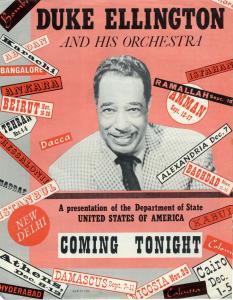
Ellington Selected as a Jazz Ambassador
The selection of African American bandleaders and interracial groups to represent the United States on these tours was a deliberate countermeasure to Soviet propaganda, which highlighted the racial injustices endured by Black Americans and other minority groups in the U.S.
Duke Ellington’s tour in 1963 occurred in the wake of several key events in the struggle for civil rights in the United States, such as the assassination of Medgar Evers; the bombing of the 16th Street Baptist Church in Birmingham, Alabama; and the March on Washington for Jobs and Freedom. In this context, it isn’t hard to imagine why the U.S. State Department was so keen to send Ellington and his band across the globe in an effort to improve the image of the United States internationally.
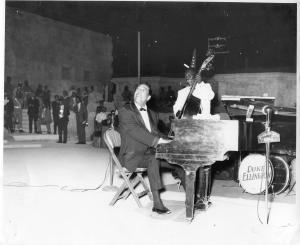
Ellington Tours the Middle East
The Booth Family Center for Special Collections holds a collection of photographs, publicity materials, and recordings that document Duke Ellington’s 1963 goodwill tour of South Asia and the Middle East.
Ellington embarked on the tour in November 1963 with two concerts in Syria. The band then traveled to Jordan’s capital, Amman, where they performed in a 2,000-year-old Roman amphitheater. According to a U.S. State Department press release, the concert was attended by members of the Jordanian royal family. Ellington would typically perform for crowds that included dignitaries, government officials, local leaders, and college students.
Soon he and the band were criss-crossing the Middle East and Asia on a tour that would take them from Syria to India and then back west to Turkey, with stops in several other countries along the way.
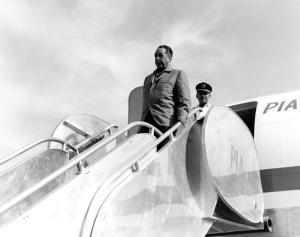
Ellington Arrives in Pakistan
Ellington’s visit to Pakistan is the most well documented tour stop in our holdings. Lewis C. Wendell, Jr. served as a Consul with the United States Information Agency in the region and helped facilitate Ellington’s visit. He saved a number of documents, photographs, and recordings from the Duke’s time in the area. His family donated the materials to the Booth Family Center for Special Collections in 2022.
The State Department’s report on Ellington’s tour stop in Lahore, Pakistan provides insight into the Jazz Diplomacy program. It notes that the Lahore visit “occurred, fortuitously, during a period of strained relations between Pakistan and the U.S.” Ellington himself was praised for his, “personal warmth, quiet dignity, and direct personality [which] proved to be a forceful statement of America’s coming of age in race relations.”
The report’s appraisal of the visit concludes: “Popular cultural events such as this, appealing to both students and public opinion leaders, potentially are the most effective program to create a new understanding and respect for American cultural achievements. They also help to generate a more receptive frame of reference for less palatable political and economic policies.”
Despite the tour’s success, it would ultimately be cut short. On November 22nd, President John F. Kennedy was assassinated in Dallas, Texas. The remainder of the goodwill tour was promptly canceled and Ellington and his Orchestra returned to the United States.
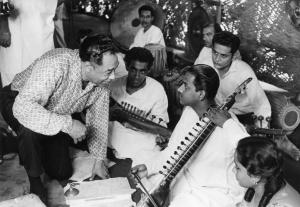
Ellington Finds Inspiration on the Tour
The goodwill tour exposed Ellington and his band to a variety of musical traditions across the globe. These two photographs document Ellington and Sam Woodyard meeting local musicians in New Delhi, including Chatur Lal, described by the State Department as "India's greatest tabla artist." The music of South Asia and the Middle East would inspire a number of Ellington’s compositions that are featured on the 1967 album Far East Suite.
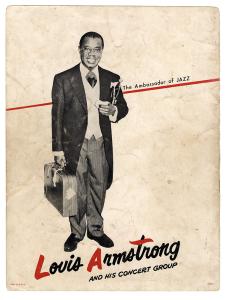
Other Jazz Ambassadors
The Booth Family Center for Special Collections also holds materials related to Louis Armstrong’s 1956 visit to Accra, Ghana (then the capital of the British Gold Coast Colony). These include concert programs, advertisements, and photographs of Armstrong with local Ghanaians. For more information, please see Anna Harwell Celenza’s exhibition Jazz Ambassador Louis Armstrong, Ghana 1956 .
Exhibition curated by John Zarrillo, Head of Archival Processing
- Share full article
Advertisement
Supported by
When Ambassadors Had Rhythm
By Fred Kaplan
- June 29, 2008
HALF a century ago, when America was having problems with its image during the cold war, Adam Clayton Powell Jr., the United States representative from Harlem, had an idea. Stop sending symphony orchestras and ballet companies on international tours, he told the State Department. Let the world experience what he called “real Americana”: send out jazz bands instead.
A photography exhibition of those concert tours, titled “Jam Session: America’s Jazz Ambassadors Embrace the World,” is on display at the Meridian International Center in Washington through July 13 and then moves to the Community Council for the Arts in Kinston, N.C. There are nearly 100 photos in the show, many excavated from obscure files in dozens of libraries, then digitally retouched and enlarged by James Hershorn, an archivist at the Institute of Jazz Studies at Rutgers University. There’s Dizzy Gillespie in 1956, charming a snake with his trumpet in Karachi, Pakistan. Louis Armstrong in ’61, surrounded by laughing children outside a hospital in Cairo. Benny Goodman in ’62, blowing his clarinet in Red Square. Duke Ellington in ’63, smoking a hookah at Ctesiphon in Iraq.
The idea behind the State Department tours was to counter Soviet propaganda portraying the United States as culturally barbaric. Powell’s insight was that competing with the Bolshoi would be futile and in any case unimaginative. Better to show off a homegrown art form that the Soviets couldn’t match and that was livelier besides. Many jazz bands were also racially mixed, a potent symbol in the mid to late ’50s, when segregation in the South was tarnishing the American image.
Jazz was the country’s “Secret Sonic Weapon” (as a 1955 headline in The New York Times put it) in another sense as well. The novelist Ralph Ellison called jazz an artistic counterpart to the American political system. The soloist can play anything he wants as long as he stays within the tempo and the chord changes just as, in a democracy, the individual can say or do whatever he wants as long as he obeys the law. Willis Conover, whose jazz show on Voice of America radio went on the air in 1955 and soon attracted 100 million listeners, many of them behind the Iron Curtain, once said that people “love jazz because they love freedom.”
The Jazz Ambassador tours, as they were called, lasted weeks, sometimes months, and made an impact, attracting huge, enthusiastic crowds. A cartoon in a 1958 issue of The New Yorker showed some officials sitting around a table in Washington, one of them saying: “This is a diplomatic mission of the utmost delicacy. The question is, who’s the best man for it John Foster Dulles or Satchmo?”
Powell arranged for Gillespie, his close friend, to make the State Department’s first goodwill jazz tour, starting out in March 1956 with an 18-piece band and traveling all over southern Europe, the Middle East and south Asia.
The band’s last stop was Athens, where students had recently stoned the local headquarters of the United States Information Service in protest of Washington’s support for Greece’s right-wing dictatorship. Yet many of those same students greeted Gillespie with cheers, lifting him on their shoulders, throwing their jackets in the air and shouting: “Dizzy! Dizzy!”
When Armstrong arrived in the Congo as part of a 1960 tour through Africa, drummers and dancers paraded him through the streets on a throne, a scene captured by a photograph in the exhibition. As late as 1971, when Ellington came to Moscow, an American diplomat wrote in his official report that crowds greeted the Duke as something akin to “a Second Coming.” One young Russian yelled, “We’ve been waiting for you for centuries!”
The stars were happy to play their parts in this pageant for hearts and minds, but not as puppets. After his Middle East tour Gillespie said with pride that it had been “powerfully effective against Red propaganda.” But when the State Department tried to brief him beforehand on how to answer questions about American race relations, he said: “I’ve got 300 years of briefing. I know what they’ve done to us, and I’m not going to make any excuses.”
Armstrong canceled a 1957 trip to Moscow after President Dwight D. Eisenhower refused to send federal troops to Little Rock, Ark., to enforce school-integration laws. “The way they are treating my people in the South, the government can go to hell,” he said. “It’s getting so bad, a colored man hasn’t got any country.”
Administration officials feared that this broadside, especially from someone so genial as “Ambassador Satchmo,” would trigger a diplomatic disaster. Secretary of State John Foster Dulles told Attorney General Herbert Brownell that the situation in Arkansas was “ruining our foreign policy.” Two weeks later, facing pressure from many quarters, Eisenhower sent the National Guard to Arkansas. Armstrong praised the move and agreed to go on a concert tour of South America.
The jazzmen’s independence made some officials nervous. But the shrewder diplomats knew that on balance it helped the cause. The idea was to demonstrate the superiority of the United States over the Soviet Union, freedom over Communism, and here was evidence that an American even a black man could criticize his government and not be punished.
The photographs in the exhibition evoke this time when American culture and politics were so finely joined. Curtis Sandberg, the curator at Meridian International, said that during the three years it took to prepare the show his staff would frequently gaze at the photos and say, “Why aren’t we doing something like this now?”
But in today’s world what would “something like this” be?
Jazz was a natural for the cold war. Soviet citizens who hated their government found anything American alluring, especially jazz (and later rock), which was such a heady contrast to Moscow’s stale official culture. The same was true, to a degree, in some of the nonaligned nations, which were under pressure from both superpowers to sway toward one side or the other.
The pianist Dave Brubeck recalled in a phone interview that, when his quartet played in 12 Polish cities in 1958, several young musicians followed the band from town to town. When he went back to Warsaw just a few years ago, one of those followers came up to him Mr. Brubeck recognized his face and said, “What you brought to Poland wasn’t just jazz. It was the Grand Canyon, it was the Empire State Building, it was America.”
What aspect of American culture would present such an appealing face now not to potential dissidents in Poland or Russia but, say, to moderate Muslims in Syria or Iran? And in a multipolar world, what would make them turn to the United States as an alternative to their own regimes?
Even in its heyday jazz diplomacy, like any sort of cultural diplomacy, was at best an adjunct to the more conventional brand. As Penny M. Von Eschen wrote in her 2004 book, “Satchmo Blows Up the World: Jazz Ambassadors Play the Cold War” (Harvard University Press), the audiences abroad “never confused or conflated their love of jazz and American popular culture with an acceptance of American foreign policy.” The biggest impact on hearts and minds comes, as always, from what the American government does .
And yet the State Department has a program in jazz diplomacy now. It’s called Rhythm Road, it’s run by Jazz at Lincoln Center (a three-year contract has just been renewed), and it sends 10 bands (mainly jazz, some hip-hop, all of which audition for the gig) to 56 countries in a year.
It’s scaled more modestly than the program of yore. For one thing, no jazz musicians for that matter, few pop stars are as famous as a Gillespie, Armstrong or Brubeck in his prime, and the jazz musicians in Rhythm Road are not well known even by today’s standards. The program’s goals are more modest too. There is no pretense of competing for geo-cultural primacy. But that is what gives this program its cogent post-cold-war spin.
The State Department doesn’t tell the musicians what to do, but some of them, either jointly or on their own, have decided to emphasize not their music’s peculiarly American quality but rather its resonance with the countries they’re visiting.
When the saxophonist Chris Byars took a band to Saudi Arabia this year, he played the music of Gigi Gryce, a jazz composer of the 1940s and ‘50s who converted to Islam and changed his name to Basheer Qusim. “When I announce that I’m going to play compositions by the American jazz musician Basheer Qusim, that gets their attention,” he said. “Afterward several people came up, very appreciative, saying very intensely, ‘Thank you for coming to our country.’ ”
Before the bass player Ari Roland went to Turkmenistan last year, he learned some Turkmen folk songs. His band played jazz improvisations of these songs with local musicians the first time such mixing had been allowed and a 15-minute news report about the concert ran on state television several times the next day.
“They saw Americans paying homage to their cultural traditions,” he said. “Several people at the concert came up and said, in effect, ‘Wow, you’re not all imperialists out to remake the world in your image.’ ”
The Jazz Ambassadors of a half-century ago did some of this too. Gillespie played sambas in South America. Goodman played a Burmese oboe with local musicians in Rangoon. But the intent was to showcase the unique and superior vitality of the United States. The task today might be, once more, to highlight that vitality but to show that it and, by implication, America itself might fit in harmoniously with the rest of the world.
An article last Sunday about jazz musicians who acted as cultural ambassadors in the 1950s and ‘60s referred incorrectly to Dizzy Gillespie’s visit to Athens in 1956. The city was the last stop on the tour, not the first. (The first was Abadan, Iran.)
How we handle corrections
Find the Right Soundtrack for You
Trying to expand your musical horizons take a listen to something new..
Celine Dion can only be herself.
Mary Timony is an indie-rock hero. Her other gig? Mentor .
Mavis Staples , an American institution, is not done singing yet.
What’s behind Charli XCX ’s “Brat” breakthrough? Hear the Popcast.
The 40 best songs of 2024 (so far).

Sukin Series
Duke Ellington’s Far East Suite
Saturday May 15, 2021
Babcock Theater
Experience Duke Ellington’s 1968 Grammy Award-winning Far East Suite as performed by the Rocky Mountain Jazz Collective.
rockymountainjazzcollective.com
Please note that masks are required at all times when in our venues. Thank you for helping us to safely present live music in Billings!
Duke Ellington’s 1968 Grammy-award winning album The Far East Suite is a reflective journey of a State-Department sponsored tour in 1963 through the Middle East and Near East as told through the eyes and ears of Ellington’s band. The final nine-piece suite is the last collaboration between Ellington and Billy Strayhorn and is widely considered to be their masterpiece. Strayhorn passed away just over five months after the album was released. The album conveys the excitement and awe the band experienced as they traveled. It continues to capture the imagination with its original scores like Tourist Point of View; Bluebird of Delhi; Isfahan; and Ad Lib on Nippon.
Rocky Mountain Jazz Collective
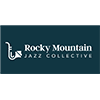
RMJC aims to increase appreciation and awareness of jazz music through the performance of themed programs consisting of material with cultural and historical significance to the history and development of jazz.

Scott Jeppesen | Saxophone
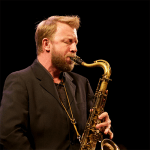
Scott is an alumnus of the University of Southern California where he earned a Bachelor of Music, Master of Music, and Doctor of Musical Arts degrees in Jazz Studies.
Prior to accepting the position at MSU Billings, Scott lived in Los Angeles for seventeen years. In that time, he performed with Maria Schneider, Bobby McFerrin, Burt Bacharach, Lalo Schifrin, Alan Pasqua, Bill Watrous, Shelly Berg, Manhattan Transfer, Stevie Wonder, Nancy Wilson, Artie Shaw, Bob Mintzer, Dave Brubeck, Natalie Cole, Louis Bellson, Al Jarreau, Steve Miller, Randy Brecker, and James Moody … just to name a few. Scott has composed and arranged for many artists including Steve Miller, Ramsey Lewis, Natalie Cole, Ruben Studdard, Dave Koz, Ledisi, Burt Bacharach, Monica Mancini, Scott Martin, and the PBS special, We Love Ella! A Tribute to Ella (Fitzgerald), which aired in the spring of 2007.
In 2009, he co-founded Cultivating Creative Minds along with his wife, Roxanne, to provide art instruction to elementary school-aged students throughout Santa Clarita, CA.
Scott has also performed clinics for many colleges, high schools, and middle schools around northern and southern California including the University of Southern California, Cal State University Sacramento, Brubeck Institute at the University of the Pacific, Cal State University Northridge, Cal State University Sonoma, American River College, West Ranch High School, Canyon High School, and Saugus High School. In addition to clinics, Scott is in demand as a featured guest artist. In 2014, Scott was the featured artist with California State University Sacramento jazz ensembles where they performed the music of the Joe Henderson Big Band. In the same year, Scott was the guest artist for the SuperJazz at the Ranch festival in Stevenson Ranch, CA, where he performed a duo set with Russell Ferrante of the legendary Yellowjackets.
John Roberts | Trombone

Feeling equally comfortable in orchestral and commercial music realms, John has toured, recorded, and performed in Los Angeles, around the U.S., and around the world, including Mexico, India, Asia, Europe, the Caribbean, Australia, and Africa. Tours include Ricardo Lemvo and Makina Loca (Congolese/Cuban), Bobby Womack (Soul), Los Pinguos (Argentine), The Temptations, The New Orleans Jazz Orchestra, and others. Other performances and recordings include multiple American and Latin Grammy concerts, Fallout Boy, Chris Botti, Feist, Sting, Dr. Dre, Jill Scott, Mariah Carey, Lady Gaga, Frank Sinatra Jr., Chaka Khan, Burt Bacharach, The Ojays, Cher, Beverly Crawford, Christina Aguilera, NPR, PBS, Disney, and others.
After 17 years based in Los Angeles, John is now on staff at MSU Billings teaching Jazz, music theory, low brass, and world music. He regularly works and performs as a clinician and guest artist in schools, continuing to hone his skills as an educator by sharing the ‘real world’ of music with his students.
John is active in Montana and Los Angeles performing and studio scenes as an arranger, bandleader, session player, and composer. Recent projects include Ricardo Lemvo’s new Cuban-West African album, Straight Outta Compton , and John’s own world-fusion record, Soul y Pimienta , which blends Cuban, African and American soul and jazz elements.
When not dabbling in the world of music, John is likely found (or not found!) gallivanting about the mountains or prairie via foot, 4WD, skis or mountain bike.
Mark Fenderson | Trumpet
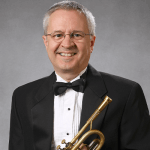
He earned his BA from the University of Southern Maine, his MM from the University of South Florida, and his DMA in trumpet performance from the University of North Texas.
He is the principal trumpet of the Billings Symphony and the Rimrock Opera Orchestra, as well as a member of the Yellowstone Chamber Players and the Billings Brass. During the summer, Dr. Fenderson is on the faculty of the Red Lodge Music Festival.
A native of Maine, he was a member of the Portland Symphony Orchestra before moving to Florida, where he taught at the University of Tampa and was a staff musician at Busch Gardens, Tampa Bay.
Erik Olson | Piano
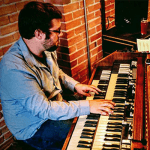
Having two musicians as parents, Erik took to music at a young age. He began taking piano lessons at 5 and was performing for crowds by the time he was 8. Upon entering high school, Erik quickly gained recognition as one of the best young musicians in the state and was already playing regularly with some of the most prominent performers in the rocky mountain region. During his secondary education at Northwest College in Powell, Wyoming, and at the University of Wyoming, Erik won awards at numerous classical and jazz competitions around the country.
Erik plays in a number of well-known Montana groups, namely Parker Brown and the Bleeding Hearts, Alex Nauman Organ Trio, Kyle Shobe, and the Walk ’em Boys, The Walkers Trio, and The Big Sky Trio. He has also performed and recorded with various country, classical, funk, rock, R&B, hip hop, and soul groups around the area. At only 28 years old, Erik has performed with jazz legends Stefon Harris, Steve Turre, and the Glenn Miller Orchestra. Other notable artists he has performed with include Nick Mancini, Ronnie Bedford, Kansas, Dave Pietro, and Eric Reed.
In 2013, Erik accepted a position at Sheridan College as a piano and saxophone instructor and is also one of the founders of Allied Music, a well-known performing arts academy located in Billings. For the past 5 years, Erik has played and taught in and around the Billings area, helping to expand Montana’s music scene.
*Programming subject to change
- May - October, 2012 Conakry, Guinea
East Asia and Pacific
- September - October, 2012 The Peace Hotel Shanghai, China
- Faculty Library of Humanities, Copenhagen University Copenhagen, Denmark
- April 2011 Baghdad, Iraq U.S. Embassy Jazz Appreciation Month
- October 2012 Kabul, Afganistan
Western Hemisphere
- February - September, 2012 Bi-National Center Tegucigalpa, Honduras
Duke Ellington
The keys to diplomacy.
Duke Ellington, the renowned composer, pianist, and internationally famed band leader, toured for the State Department more than any other musician. This began with his orchestra’s three-month swing through the Middle East and South Asia in 1963 and ended with performances in Eastern Europe, Ethiopia, and Zambia in 1973.
The first trip included Syria, Jordan, Afghanistan, India, Ceylon, Pakistan, Iran, Iraq, Lebanon, and Turkey. The Washington, DC native won over the public and diplomats alike with his warmth and charisma both on and off stage. Despite a grueling schedule of travel and performances, interrupted by periodic illnesses, Ellington delighted State Department officials who described him as “without fail gracious, articulate, charming, and absolutely winning,” and judged the band as “excellent ambassadors and representatives of America.” The Duke’s encounters with local musicians and unfamiliar musical forms influenced his composition and can be heard in his album Far East Suite. This tour was tragically cut short by the assassination of President Kennedy on November 22, 1963. In Turkey, Ellington sat up all night composing memorial music for the slain President, feeling strongly that continuing to perform was a better way to honor Kennedy than canceling concerts. The band was ultimately recalled to the U.S., but this trip proved to be just the beginning of Ellington’s far-reaching travels as a Jazz Ambassador.
There were State Department appearances in 1966 at the First World Festival of Negro Arts in Dakar, Senegal, and tours of Latin America and Asia in the early 1970s, but Ellington’s greatest diplomatic triumph came in 1971 when his orchestra toured the Soviet Union. This trip followed the announcement of President Richard Nixon’s impending visit to the USSR and promotional materials for Ellington playfully presented him as the front man for the President! The Ellington Orchestra played to ecstatic crowds in five cities. In Moscow, tickets were scalped for the then extraordinary sum of fifty dollars each as travelers descended on the city from distant points in the Soviet Union. With musicians and State Department personnel meeting surreptitiously at jazz clubs far into the night and even diving out of windows as the police arrived, jazz critic Leonard Feather called the tour “the greatest coup in the history of musical diplomacy.”
Subsequent to this trip and during the last three years of his life, Ellington’s activities for the State Department actually accelerated. The seventy-two-year-old Duke immediately followed the Soviet experience with performances in Eastern Europe and a tour of Latin America in late 1971. He visited Asia in 1972, including concerts in Vientiane, Laos, while the Vietnam War unfolded around them. In late 1973, he made his final State Department appearances in Zambia and Ethiopia, where he gave a command performance before Emperor Haile Selassie who presented him with a medal. Ellington became fast friends with the Ethiopian jazz fusionist Mulatu Astatqé as the two musicians brought their bands together to improvise with traditional Ethiopian and Western instruments. Already suffering from advanced lung cancer, but traveling nonetheless, Duke passed away the following spring.
- | Home
- | Schedules
- | Exhibition Materials
- | Credits
- | Quincy Jones
- | Louis Armstrong
- | Dave Brubeck
- | Duke Ellington |
- | Dizzy Gillespie
- | Benny Goodman
- | Newport
- | Others |
- Meridian International Center |
- Photographic Restoration |

The Global Source for Jazz

- Advanced Search
The Far East Suite
The Far East Suite is one of the more interesting and unique creations in the Ellington/Strayhorn oeuvre. It’s a reflective, evocative, virtuosic, impressionistic aural tour through the East (mostly the Middle and Near East as many have pointed out over the years) as seen through the eyes and ears of two men who were musical visionaries and who had musicians behind them who were capable of vividly enunciating their visions.
The Ellington Band went on a State Department-sponsored tour in 1963 which took them to Syria, Jordan, India, Sri Lanka (then known as Ceylon), Pakistan, Iran (then Persia), Lebanon, and Turkey. These travels-along with a 1964 tour of Japan-served as the primary inspiration for a musical suite. This concept piece had a long and complex development. The first iteration, then known as Impressions of the Far East, was initially performed in early 1964 in England and consisted of four movements: Ellington's Amad and Depk, and Agra and Bluebird of Delhi by Strayhorn.
By the time The Far East Suite was recorded in December of 1966 it had grown to its final length of nine pieces. These pieces had various origins and sources of inspiration; some were even previously written at least in part. The overall cohesiveness and maturity of the suite can partly be attributed to its long gestation period, as pieces were refined and re-worked over a lengthy period of time. They came together to form what is generally considered to be one of Ellington and Strayhorn’s masterpieces; it can also rightfully be seen as the swan song of their historic collaboration, as Strayhorn was very ill when it was recorded and passed away just over five months later.
When completed, The Far East Suite was meant to convey the excitement and awe felt by the band when traveling to lands that were truly foreign-exotic and totally different from what most of them had experienced before. It’s all there in the music-themes, motifs, form, harmonic progressions, and ideas that convey exhilaration, joy, sadness, and various musical incantations of the mystery of life in the East.
The opening tune, Ellington’s Tourist Point of View, conveys the sense of wonder at arriving in the East after landing in Syria. Mainly a vehicle for tenor sax star Paul Gonsalves, the piece creates a wide-ranging and diverse introduction to the suite with a sense of excitement at the sounds, sights, and exotic differences they were experiencing.
Strayhorn’s Bluebird of Delhi (originally titled Mynah) is a tribute to a mynah bird that often visited his room while the band was in India. Jimmy Hamilton’s clarinet evokes the sound and spirit of the bird, with Hamilton mimicking the “pretty lick” (in Ellington's words) that the bird used to sing. According to Duke, the bird never answered Billy’s banter until they were leaving, and “then it sounded off the low raspberry you hear at the end of the number.” 1
Isfahan was based on an earlier Strayhorn work called Elf, which was first performed in 1963. Named after Persia/Iran's former capital, it was inspired by what Ellington called “a city of poetic beauty.” 2 Isfahan became the best-known piece on the record, in no small part due to Johnny Hodges’s stunningly beautiful work on this cut; few players were more suited to mirror poetic beauty with their playing than Hodges. Isfahan also became the only popular standard from the suite, largely due to its more familiar form.
Ellington’s Depk was inspired by a children’s dance in Amman, Jordan, adding playfulness and a child’s sense of hope and optimism to the suite. Depk, Ellington recalled, “involved a dozen boys and girls and was marked by a little kick on the sixth beat.” 3 This “kick” is musically represented by the occasional use of tags and extended phrases throughout the piece.
Next comes Ellington’s Mount Harissa, originally known as Nob Hill, which takes its name from a famous hilltop in Lebanon. This movement showcases his sometimes underrated piano playing. Once again is Paul Gonsalves on tenor, showcasing a more sprightly, upbeat approach than his earlier spots on Tourist Point of View. It’s a particularly evocative piece, which continues to develop the themes of the suite while spotlighting the interplay between Ellington and one of his most trusted lieutenants.
Duke’s Blue Pepper, originally known as 3D, stands out somewhat with its shift to a rock-and-roll-style backbeat. It’s almost an interlude on the record; a sort of upbeat palate cleanser for the ears. Highlights include Hodges’s stellar alto sax and Cat Anderson’s high note acrobatics over the melody recap. Strayhorn’s Agra is named for the Indian city which is home to the world-famous Taj Mahal. Indian motifs are clearly evident in this piece. It was written to feature Harry Carney’s baritone sax, which brings to mind the majesty, beauty, and deep emotions extant in the legendary Indian landmark and its backstory. Ellington’s Amad works to convey the overall mystery of the region. Famed critic Stanley Dance drew attention to Lawrence Brown’s trombone performance in particular, which is no doubt meant to evoke an Islamic “call to prayer.” 4
Finally, Ad Lib on Nippon was composed by Ellington and tenor sax/clarinetist Jimmy Hamilton after the aforementioned 1964 visit to Japan. This movement consists of four sections: Fugi, Igoo, Nagoya, and Tokyo. Fugi and Nagoya, largely piano pieces, showcase Ellington. Igoo was composed originally for an American Airlines short advertising film entitled Astrofreight. Hamilton’s playing and his oral history comments on the Tokyo section strongly suggest that this was his composition. Ad Lib has a distinct Eastern feel, perhaps due to the legacy of Ellington’s many visits to Japan; his piano solo is especially moving.
The Far East Suite is a landmark work. Aside from its beauty, creativity, originality, and cohesiveness-despite the diverse nature of the pieces-it stands out in many ways. As critics have noted, the “Eastern” feel is achieved with standard big band instrumentation familiar to the Ellington canon-they did not introduce Eastern instruments to more easily evoke the sounds of the region as many others in various genres of music have done. Instead, uses of themes, motifs, form, and vamps familiar to various Asian music traditions were subtly incorporated to create the unique sound palette. The individual musicians were used in the same way: Hamilton’s clarinet represents the mynah bird, Hodges’s alto evokes the poetic beauty of Isfahan, Gonsalves’s tenor builds on Ellington’s feelings about Mount Harissa, and Carney’s baritone conveys the majesty of the Taj Mahal and its history.
In addition, this work, while clearly bearing all of the marks of its creators, also heavily reflects the freer trends and overall change coursing through the music world in the second half of the 1960s. In a new way, Ellington and Strayhorn reinforced their idea that big band music belonged in a concert hall. One might also be very tempted to consider this to be among Ellington's more accessible works, containing a range of universal emotions ranging from the exotic to the playful.
Ultimately, this piece, listened to in its entirety, is an adventurous musical journey away from the comfort zone of most listeners and even to some degree of the players. Still, the familiar instruments and easily-recognizable composer/arrangers and soloists firmly root this work in the Ellingtonian canon and within the jazz tradition as well. The influences of the East were mixed perfectly with the familiar style of the Ellington band as a group and the individuality of its members. The Far East Suite succeeds in blending old and new, different and familiar; presenting a truly singular musical look at cultures entirely foreign to most Westerners, yet conveying emotions every person could relate to and appreciate-and doing it all in a way that is also just plain fun to listen to again and again.
1 Walter van de Leur, Something to Live For, Oxford, NY, 2002. p 167.
2 Walter van de Leur, Something to Live For, Oxford, NY, 2002. p 169.
3 Neil Tesser: http://www.jazzhouse.org/library/index.php3?read=tesser2.
4 Neil Tesser: http://www.jazzhouse.org/library/index.php3?read=tesser2.
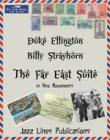
DUKE ELLINGTON'S FAR EAST SUITE & BLACK, BROWN, AND BEIGE: COMPLETE TWO WORK SET
Recorded by the Duke Ellington Orchestra
Arranged by Duke Ellington and Billy Strayhorn
18 Jazz Big Band Arrangements
Jazz Lines Publications
![FAR EAST SUITE [COMPLETE SCORE ONLY - DOWNLOAD] View: FAR EAST SUITE [COMPLETE SCORE ONLY - DOWNLOAD]](https://www.ejazzlines.com/wp-images/product/thumbnail/jlp7350_sm.jpg)
FAR EAST SUITE [COMPLETE SCORE ONLY - DOWNLOAD]
Composed and Arranged by Duke Ellington and Billy Strayhorn
Nine Jazz Big Band Arrangements [COMPLETE SCORE]
JLP-7350SDL
![FAR EAST SUITE [COMPLETE SCORE] View: FAR EAST SUITE [COMPLETE SCORE]](https://www.ejazzlines.com/wp-images/product/thumbnail/jlp7350_sm.jpg)
FAR EAST SUITE [COMPLETE SCORE]
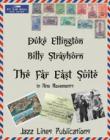
FAR EAST SUITE: JAZZ LINES PUBLICATIONS COMPLETE NINE ARRANGEMENT SET
Nine Jazz Big Band Arrangements
![FAR EAST SUITE: JAZZ LINES PUBLICATIONS COMPLETE NINE ARRANGEMENT SET [DOWNLOAD] View: FAR EAST SUITE: JAZZ LINES PUBLICATIONS COMPLETE NINE ARRANGEMENT SET [DOWNLOAD]](https://www.ejazzlines.com/wp-images/product/thumbnail/jlp7350_sm00.jpg)
FAR EAST SUITE: JAZZ LINES PUBLICATIONS COMPLETE NINE ARRANGEMENT SET [DOWNLOAD]
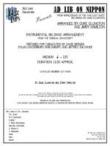
AD LIB ON NIPPON (FROM THE FAR EAST SUITE)
Arranged by Duke Ellington, Prepared by David Berger, Dylan Canterbury, Rob DuBoff, and Jeffrey Sultanof
Jazz Big Band Arrangement
![AD LIB ON NIPPON (FROM THE FAR EAST SUITE) [DOWNLOAD] View: AD LIB ON NIPPON (FROM THE FAR EAST SUITE) [DOWNLOAD]](https://www.ejazzlines.com/wp-images/product/thumbnail/jlp7409.jpg)
AD LIB ON NIPPON (FROM THE FAR EAST SUITE) [DOWNLOAD]
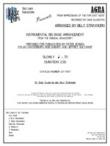
AGRA (FROM THE FAR EAST SUITE)
Composed and Arranged by Billy Strayhorn, Prepared by Rob DuBoff and Jeffrey Sultanof
![AGRA (FROM THE FAR EAST SUITE) [DOWNLOAD] View: AGRA (FROM THE FAR EAST SUITE) [DOWNLOAD]](https://www.ejazzlines.com/wp-images/product/thumbnail/jlp7407.jpg)
AGRA (FROM THE FAR EAST SUITE) [DOWNLOAD]
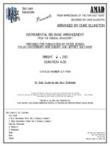
AMAD (FROM THE FAR EAST SUITE)
Arranged by Duke Ellington, Prepared by Peter Jensen, Rob DuBoff, Dylan Canterbury, and Jeffrey Sultanof
![AMAD (FROM THE FAR EAST SUITE) [DOWNLOAD] View: AMAD (FROM THE FAR EAST SUITE) [DOWNLOAD]](https://www.ejazzlines.com/wp-images/product/thumbnail/jlp7408.jpg)
AMAD (FROM THE FAR EAST SUITE) [DOWNLOAD]
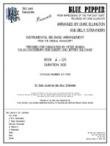
BLUE PEPPER (FROM THE FAR EAST SUITE)
Arranged by Duke Ellington and Billy Strayhorn, Prepared by Rob DuBoff and Jeffrey Sultanof
![BLUE PEPPER (FROM THE FAR EAST SUITE) [DOWNLOAD] View: BLUE PEPPER (FROM THE FAR EAST SUITE) [DOWNLOAD]](https://www.ejazzlines.com/wp-images/product/thumbnail/jlp7406.jpg)
BLUE PEPPER (FROM THE FAR EAST SUITE) [DOWNLOAD]
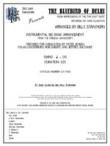
BLUEBIRD OF DELHI, THE (FROM THE FAR EAST SUITE)
Composed and Arranged by Billy Strayhorn, Prepared by Peter Jensen, Rob DuBoff, Dylan Canterbury, and Jeffrey Sultanof
![BLUEBIRD OF DELHI, THE (FROM THE FAR EAST SUITE) [DOWNLOAD] View: BLUEBIRD OF DELHI, THE (FROM THE FAR EAST SUITE) [DOWNLOAD]](https://www.ejazzlines.com/wp-images/product/thumbnail/jlp7402.jpg)
BLUEBIRD OF DELHI, THE (FROM THE FAR EAST SUITE) [DOWNLOAD]
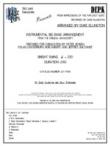
DEPK (FROM THE FAR EAST SUITE)
![DEPK (FROM THE FAR EAST SUITE) [DOWNLOAD] View: DEPK (FROM THE FAR EAST SUITE) [DOWNLOAD]](https://www.ejazzlines.com/wp-images/product/thumbnail/jlp7404.jpg)
DEPK (FROM THE FAR EAST SUITE) [DOWNLOAD]
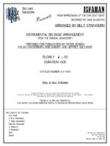
ISFAHAN (FROM THE FAR EAST SUITE)
![ISFAHAN (FROM THE FAR EAST SUITE) [DOWNLOAD] View: ISFAHAN (FROM THE FAR EAST SUITE) [DOWNLOAD]](https://www.ejazzlines.com/wp-images/product/thumbnail/jlp7403.jpg)
ISFAHAN (FROM THE FAR EAST SUITE) [DOWNLOAD]
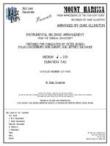
MOUNT HARISSA (FROM THE FAR EAST SUITE)
![MOUNT HARISSA (FROM THE FAR EAST SUITE) [DOWNLOAD] View: MOUNT HARISSA (FROM THE FAR EAST SUITE) [DOWNLOAD]](https://www.ejazzlines.com/wp-images/product/thumbnail/jlp7405.jpg)
MOUNT HARISSA (FROM THE FAR EAST SUITE) [DOWNLOAD]
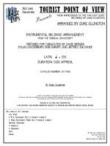
TOURIST POINT OF VIEW (FROM THE FAR EAST SUITE)
![TOURIST POINT OF VIEW (FROM THE FAR EAST SUITE) [DOWNLOAD] View: TOURIST POINT OF VIEW (FROM THE FAR EAST SUITE) [DOWNLOAD]](https://www.ejazzlines.com/wp-images/product/thumbnail/jlp7401.jpg)
TOURIST POINT OF VIEW (FROM THE FAR EAST SUITE) [DOWNLOAD]

- Private Lessons
- Group Lessons

Duke Ellington and the Far East Suite
The 60s were a turbulent time in the United States. The decade was significantly interesting, however, when it came to music and what a few countries in the Middle East experienced during a 14/15 week tour of one of the best known jazz pianists of time. Known to be charming and an exceptional leader of his ensemble, Duke Ellington “hit the road” and started a journey of presentation and absorption. Why it was that during a time of political and social clashes between African Americans and white supremacy, Jazz–and especially Duke Ellington–was sent to these strategically chosen locations, is unclear. What is of significance though is that Duke Ellington seems to have come back from this journey enriched just as much as he was going there to enrich others. There are different stories about what he experienced while on this tour, but one that stands out particularly for me is the story of him having a concert in Kabul. The story goes that in the middle of the concert, Duke Ellington noticed people started to walk away in masses, and soon he realized it was time for evening prayer. Apparently, he stopped the concert in respect for the prayer time, and proceeded with it after prayers were over. There is no way to fact check this, specially since when he retells the story, he does not mentions stopping the concert. I have a liking for the first version, and knowing Duke Ellington’s characteristics: faithful, religion, and devotional, it seems like the kind of thing he would do.
RHYTHMITICA | Online Music Academy
At Rhythmitica, we believe in the power of music to inspire, enrich, and transform lives. Our mission is to provide accessible, high-quality music education to learners of all ages and skill levels, regardless of geographic location or background. Whether you’re a complete beginner or an advanced musician, our comprehensive curriculum offers something for everyone.
RITMITIKIDS
- Privacy policy
- Terms and Conditions

© 2024, RHYTHMITICA INC. All rights reserved.
JAZZ IMPRESSIONS
Exploring musical connections one track at a time…

Duke Ellington – Blue Pepper (Far East of the Blues)
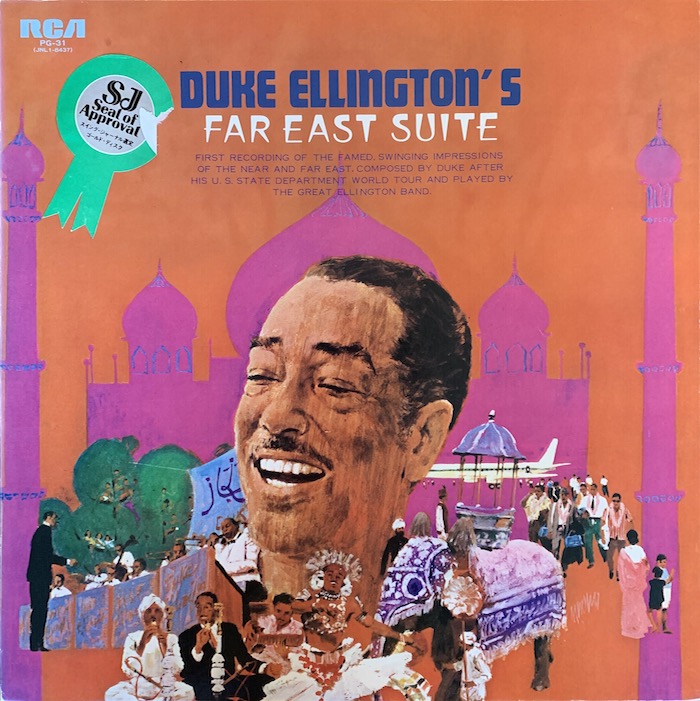
The last post looked at Duke Ellington’s album Money Jungle , a meeting of three of the greatest minds in jazz. We continue our journey with Ellington, this time looking at how he turned to the East for inspiration for his 1967 album, Far East Suite .
Far East Suite was recorded in December 1966, a couple of years after Ellington and his band had returned from a trip to the Middle East and India in 1963 and a tour of Japan in 1964. Composed by Ellington and his long-time collaborator Billy Strayhorn, Ellington sought to capture what he called ‘the exotic beauty’ of the countries they had visited.
These overseas tours, along with those by Louis Armstrong, Dizzy Gillespie and others, had been sponsored by the US State Department as part of the Jazz Ambassadors programme in a bid to improve the image of the US abroad during the Cold War. The country’s global reputation had been damaged by Russian focus on the racial inequality and discrimination in the US.
The tours were a moral dilemma for the ‘jazz ambassadors’ as they were being asked to promote the music of a country which allowed segregation and denied black citizens equal rights. Despite this, the tours went ahead and the musicians used touring as means for their own cultural exchange and the opportunity to share ‘American Music’, as Ellington preferred to call it, with the rest of the world. These tours would prove essential to the spread of jazz beyond the West, inspiring musicians overseas to explore new approaches to jazz.
However, the influence of the East on Western jazz was not a new development. Artists like Yusef Lateef had drawn inspiration from the East from as early as 1957 but Ellington’s approach was different. He didn’t just copy Eastern melodies but allowed them to inform his own style of composition. As he remarks in the album’s liner notes: ‘It’s more valuable to have absorbed while there. You let it roll around, undergo a chemical change, and then seep out on paper in the form that will suit the musicians who are going to play it.’
Ellington rejected using Eastern instruments to merely make the music sound ‘exotic’, instead producing complex arrangements, subtly inspired by the band’s experiences on tour. The first track on the album ‘Tourist Point Of View’ illustrates how Ellington tried to present a personal impression of the East and not a sweeping generalisation reducing the East to a series of musical cliches.
‘Blue Pepper (Far East of the Blues)’ is the funkiest offering on the album and as Stanley Dance remarks in the liner notes, ‘speaks of the universality of the blues’. It’s a simple track but is bursting with attitude, the musical equivalent of a chilli pepper. The mood on this track reminds me of Sun Ra’s big band compositions where horns blast, saxes screech and the band swings. Ellington would go on to echo this sound on his funky 70s offering ‘Didgeridoo’ , another favourite from the vast Ellington catalogue which fuses raunchy big band blues with a monstrous breakbeat.
By the time Ellington died, he had composed over 3000 songs with a recording career spanning 50 years. Far East Suite was one of the highlights, winning the Grammy Award in 1968 for ‘Best Instrumental Jazz Performance – Large Group or Soloist with Large Group’. On this album, Ellington succeeded in tastefully capturing the spirit of his experiences out East, using them to inform and influence his compositions for a Western audience.
Finally, if this has got you in the mood, be sure to check out our ‘Facing East’ playlist for more Eastern-inspired jazz joints. Or if you’d prefer some more big band bangers, throw on our ‘Big Band Bonanza’ playlist!
If you enjoyed this post and want to stay updated, make sure to subscribe to our Spotify playlist and follow us on Instagram and Twitter !
Author: Ollie
Music lover, avid record collector and hip hop head with a passion for jazz. Particular interests include modal, spiritual and independent jazz, Japanese sounds, prog and psych rock, library and private press oddities, ambient, minimal and all sorts of other things in between. View all posts by Ollie
Give Now Contact Us
- This event has passed.

Melodic Wanderlust: Duke Ellington’s Far East Suite
Home » Events » Melodic Wanderlust: Duke Ellington’s Far East Suite
Originally titled “Impressions Of The Far East,” this Duke Ellington/Billy Strayhorn suite was inspired by the Ellington Orchestra’s State Department-sponsored tour of the Far and Middle East in the fall of 1963. Reuben Jackson explores this extended work, which is imaginative and swinging, radical yet accessible.
Register to attend this event
This in-person event will also be live streamed. Please register so that we can send you the link for the live stream and so we can share with you other information about the event.
About the Presenters

Accessibility
Please contact us at [email protected] for information on disability services. To request a specific accommodation, contact us at least three weeks prior to the event.
- Google Calendar
- Outlook 365
- Outlook Live

Poet Sarah Audsley joined us at the Taconic Mountains Ramble State Park for Words in the Woods.

Humanities Camps are filled with reading and writing projects, field trips, and outdoor activities.

We won a 2020 Schwartz Prize for best public humanities programming in the U.S. for Vermont Reads 2019: “March: Book One.”

We supported Historic New England’s “More than a Market” project that explored the experiences of new Americans through food markets.

Our free public events help bring the power of the humanities to communities across Vermont.
Scope and Contents
Arrangement, biographical/historical note, administration, using the collection.
Usage conditions may apply for digital images, video, and sound recordings linked within SOVA collections. While digital content may be restricted, SOVA collection descriptions and catalog records are available CC0 for re-use. For more information, visit the Smithsonian's Terms of Use page.
- Download Finding Aid (PDF)
- Download EAD Metadata (XML)
Archives Center, National Museum of American History
Guide to the naomi huber brown papers (documenting duke ellington's concert tour of asia).

Duke Ellington
- Born April 29 , 1899 · Washington, District of Columbia, USA
- Died May 24 , 1974 · New York City, New York, USA (metastasized lung cancer and pneumonia)
- Birth name Edward Kennedy Ellington
- Height 6′ 1″ (1.85 m)
- Composer ("It Don't Mean a Thing if It Ain't Got That Swing", "Sophisticated Lady", "Mood Indigo", "Solitude", "In a Mellotone", "Satin Doll"), pianist and conductor, holder of an honorary music degree from Wilberforce University and an LHD from Milton College, Duke Ellington led his own orchestra by 1918, and came to New York in 1923, appearing at the Cotton Club between 1927 and 1932. Making his first European tour in 1933, he followed with his annual Carnegie Hall concerts between 1943 and 1950, and then a Middle East tour (under the auspices of the State Department), including an appearance at the International Fair in Damascus in 1963. His stage scores include "Jump for Joy" and "Beggars Holiday" (Broadway). He made many records. Joining ASCAP in 1953, his chief musical collaborators included Billy Strayhorn , Irving Mills , Mitchell Parish , Mann Curtis , Barney Bigard , Henry Nemo , Bob Russell , Don George , Lee Gaines , Paul Francis Webster , Edgar De Lange , Johnny Hodges , Cootie Williams , Juan Tizol and his own son, Mercer Ellington . His other popular song and instrumental compositions include "Blind Man's Buff", "Creole Love Call", "Black and Tan Fantasy", "I Let a Song Go Out of my Heart", "Rockin' in Rhythm", "Caravan", "Pyramid", "Creole Rhapsody", "Don't Get Around Much Anymore", "I Got It Bad and That Ain't Good", "I'm Beginning to See the Light", "In a Sentimental Mood", "East St. Louis Toodle-oo", "Birmingham Breakdown", "Black Beauty", "Flaming Youth", "Awful Sad", "The Duke Steps Out", "Saturday Night Function", "Old Man Blues", "Ring Dem Bells", "Drop Me Off in Harlem", "Daybreak Express", "Delta Serenade", "Reminiscing in Tempo", "In a Jam", "Clarinet Lament", "Echoes of Harlem", "Dusk on the Desert", "Lost in Meditation", "Blue Reverie", "I've Got to Be a Rug Cutter", "Please Forgive Me", "Chatterbox", "Harmony in Harlem", "If You Were in My Place", "Skronch", "Braggin' in Brass", "Blue Light", "Buffet Flat", "The Gal from Joe's", "Subtle Lament", "Old King Dooji", "Boy Meets Horn", "Stevedore's Serenade", "You Gave Me the Gate and I'm Swinging", "Grievin'", "The Sergeant Was Shy", "Tootin' Through the Roof", "Rumpus in Richmond", "Jack the Bear", "Me and You", "Flaming Sword", "Harlem Air Shaft", "Bojangles", "Portrait of Bert Williams", "Do Nothin' Till You Hear from Me" (Concerto for Cootie), "Kind of Moody" (Serenade to Sweden), "Morning Glory", "Blue Goose", "Cotton Tail", "Conga Brava", "Chocolate Shake", "Rocks in My Bed", "San Juan Hill", "Crescendo in Blue", "Diminuendo in Blue", "Dusk", "C Jam Blues", "Main Stem", "I Didn't Know About You", "Just a-Sittin' and a-Rockin'", "Jazz Convulsions", "I'm Just a Lucky So and So", "The Blues", "Come Sunday", "Magenta Haze", "Just Squeeze Me", "Happy-Go-Lucky Local", "Takle Love Easy", "Tomorrow Mountain", "I'm Gonna Go Fishin'", "Money Jungle", "Prelude to a Kiss", "Jump for Joy", "I'm Checking Out, Goom-Bye", "The Mooche", "Warm Valley", "Blue Serge", "I Wish I Was Back in My Baby's Arms", "Lament for a Lost Love", "It Shouldn't Happen to a Dream", "Afro-Bosso", "In the Beginning, God" and "Christmas Surprise". - IMDb Mini Biography By: Hup234!
- Spouse Edna Thompson (July 2, 1918 - 1967) (her death, 1 child)
- Children Mercer Ellington
- Parents James Edward Ellington Daisy Kennedy Ellington
- Relatives Ruth Ellington (Sibling) Mercedes Ellington (Grandchild) Paul Ellington (Grandchild) Edward Ellington (Grandchild) Gaye Ellington (Grandchild) Romare Bearden (Cousin)
- Ellington was celebrated in Stevie Wonder 's song "Sir Duke" (from "Songs in the Key of Life" (1976)).
- (July 16, 2008) Pictured in silhouette in a poster for the film Black and Tan (1929) on a 42¢ USA commemorative postage stamp celebrating Vintage Black Cinema.
- Interred at Woodlawn Cemetery, The Bronx, NY (Division 49, at Fir & Knollwood Avenues).
- He was awarded the Star on the Hollywood Walk of Fame for Recording at 6535 Hollywood Boulevard in Hollywood, California.
- Pictured on a 22¢ US commemorative postage stamp in the Performing Arts series (97th anniversary of his birth).
- I'm a telephone freak, the greatest invention since peanut brittle.
- [in reply to a question about how he got the scar on his face] I have four stories about it, and it depends on which you like the best. One is a taxicab accident; another is that I slipped and fell on a broken bottle; then there is a jealous woman; and last is Old Heidelberg, where they used to stand toe to toe with a saber in each hand, and slash away. The first man to step back lost the contest, no matter how many times he'd sliced the other. Take your pick.
- I'm the world's worst disciplinarian. There's too much responsibility in being a leader! You have to have the dignity and authority of a leader, and that's all so heavy!
- I like any and all of my associations with music: writing, playing, and listening. We write and play from our perspective, and the audience listens from its perspective. If and when we agree, I am lucky.
- I am a bandleader and I am a composer.
Contribute to this page
- Learn more about contributing
More from this person
- View agent, publicist, legal and company contact details on IMDbPro
More to explore
Recently viewed.

my newport
newport news
newport events
Melodic wanderlust: duke ellington’s far east suite.
Originally titled “Impressions Of The Far East,” this Duke Ellington/Billy Strayhorn suite was inspired by the Ellington Orchestra’s State Department-sponsored tour of the Far and Middle East in the fall of 1963. Reuben Jackson explores this extended work, which is imaginative and swinging, radical yet accessible.

Add this event to your calendar
Google Calendar
Apple Calendar
Export .ics file
Outlook Live
Outlook 360
- Skip to main content
- Keyboard shortcuts for audio player

Music Reviews
- LISTEN & FOLLOW
- Apple Podcasts
- Google Podcasts
- Amazon Music
Your support helps make our show possible and unlocks access to our sponsor-free feed.
50 years later, Steely Dan's 'Pretzel Logic' still sounds fresh

By 1974, Steely Dan's two albums had helped established the band as a viable business proposition. With Pretzel Logic, they began a quest for studio perfectionism that would last for decades to come.
Copyright © 2024 NPR. All rights reserved. Visit our website terms of use and permissions pages at www.npr.org for further information.
NPR transcripts are created on a rush deadline by an NPR contractor. This text may not be in its final form and may be updated or revised in the future. Accuracy and availability may vary. The authoritative record of NPR’s programming is the audio record.

IMAGES
VIDEO
COMMENTS
The third State Department tour of the Middle East which sent Duke Ellington and His Orchestra on the bumpy roads of the troubled region became legendary mostly thanks to the Grammy winner Far East Suite, released four years after the journey.First contradiction was the name: with exception of a tune from Japan's tour of 1964 (Ad Lib on Nippon), the rest were songs about and inspired by the ...
The US State Department had sent Duke Ellington and His Orchestra over for a Middle East Tour as a US public relations effort-"Jazz Diplomacy". In addition to Jazz musicians, other American artists did similar "Good Will" tours": Orson Welles and Walt Disney went to South America in the 40's. After Ellington's tour, the Far East ...
Middle East - 1963. Duke Ellington performs with his orchestra in a 2,000-year-old Roman amphitheatre in Amman, Jordan, during his tour of the Middle East for the US State Department. Getty Images. This was a historic tour with US government approval. Supported by the Department of State, legendary composer and pianist Duke Ellington swung ...
To begin with, it shouldn't be the Far East Suite at all. The 1963 State Department tour that this music commemorates brought Duke Ellington and his famous orchestra to Ceylon (now Sri Lanka), Egypt, India, Iraq, Jordan, Lebanon, Pakistan, Persia (now Iran), and Turkey -- a glorious itinerary of the Near and Middle East, but not a truly Far Eastern city in the lot.
The Booth Family Center for Special Collections holds a collection of photographs, publicity materials, and recordings that document Duke Ellington's 1963 goodwill tour of South Asia and the Middle East. Ellington embarked on the tour in November 1963 with two concerts in Syria.
Duke Ellington in '63, smoking a hookah at Ctesiphon in Iraq. ... After his Middle East tour Gillespie said with pride that it had been "powerfully effective against Red propaganda." But ...
Duke Ellington's 1968 Grammy-award winning album The Far East Suite is a reflective journey of a State-Department sponsored tour in 1963 through the Middle East and Near East as told through the eyes and ears of Ellington's band. The final nine-piece suite is the last collaboration between Ellington and Billy Strayhorn and is widely considered to be their masterpiece.
Duke Ellington, the renowned composer, pianist, and internationally famed band leader, toured for the State Department more than any other musician. This began with his orchestra's three-month swing through the Middle East and South Asia in 1963 and ended with performances in Eastern Europe, Ethiopia, and Zambia in 1973.
The Far East Suite is one of the more interesting and unique creations in the Ellington/Strayhorn oeuvre. It's a reflective, evocative, virtuosic, impressionistic aural tour through the East (mostly the Middle and Near East as many have pointed out over the years) as seen through the eyes and ears of two men who were musical visionaries and who had musicians behind them who were capable of ...
Duke Ellington and the Far East Suite The 60s were a turbulent time in the United States. The decade was significantly interesting, however, when it came to music and what a few countries in the Middle East experienced during a 14/15 week tour of one of the best known jazz pianists of time.
Blue Pepper (Far East of the Blues) Duke Ellington. Far East Suite was recorded in December 1966, a couple of years after Ellington and his band had returned from a trip to the Middle East and India in 1963 and a tour of Japan in 1964. Composed by Ellington and his long-time collaborator Billy Strayhorn, Ellington sought to capture what he ...
Far East Suite is a 1967 concept album by American jazz musician Duke Ellington, inspired by his group's tour of Asia.Ellington and longtime collaborator Billy Strayhorn wrote the compositions.. Strayhorn died in May 1967, making Far East Suite one of the last albums recorded during his life to feature his compositions. The album won the Grammy Award in 1968 for Best Instrumental Jazz ...
In summer 1963, Duke Ellington headed to the Middle East and India on his first Jazz Ambassador tour. In a rare Swedish Television interview, he discusses the plight of African Americans, their ...
October 11, 2023: 7:00 pm. Originally titled "Impressions Of The Far East," this Duke Ellington/Billy Strayhorn suite was inspired by the Ellington Orchestra's State Department-sponsored tour of the Far and Middle East in the fall of 1963. Reuben Jackson explores this extended work, which is imaginative and swinging, radical yet accessible.
Naomi Huber Brown was the United States Foreign Service officer that was responsible for the administration of Duke Ellington's State Department tour of the Middle East and Asia in 1963. Her duties included scheduling travel and making arrangements for the members of the Ellington Orchestra, and the distribution of appropriate currencies to the ...
Making his first European tour in 1933, he followed with his annual Carnegie Hall concerts between 1943 and 1950, and then a Middle East tour (under the auspices of the State Department), including an appearance at the International Fair in Damascus in 1963. His stage scores include "Jump for Joy" and "Beggars Holiday" (Broadway).
Edward Kennedy "Duke" Ellington (April 29, 1899 - May 24, 1974) was an American jazz pianist, composer, and leader of his eponymous jazz orchestra from 1923 through the rest of his life.. Born and raised in Washington, D.C., Ellington was based in New York City from the mid-1920s and gained a national profile through his orchestra's appearances at the Cotton Club in Harlem.
Making his first European tour in 1933, he followed with his annual Carnegie Hall concerts between 1943 and 1950, and then a Middle East tour (under the auspices of the State Department), including an appearance at the International Fair in Damascus in 1963. His stage scores include "Jump for Joy" and "Beggars Holiday" (Broadway).
Originally titled "Impressions Of The Far East," this Duke Ellington/Billy Strayhorn suite was inspired by the Ellington Orchestra's State Department-sponsored tour of the Far and Middle East in the fall of 1963. Reuben Jackson explores this extended work, which is imaginative and swinging, radical
2. Victory Park. 36. Parks. 3. Kuzbass State Museum of Local Lore. 29. Speciality Museums. The Kuzbass state museum of local lore - the leading and oldest museum of Kuzbass, the center of research, local history and methodical work in the area, has been open in 1929.
It's a salute to the saxophone great Charlie Parker. And "East St. Louis Toodle‐oo" is a cover of a jaunty 1920s instrumental by Duke Ellington. (SOUNDBITE OF STEELY DAN'S "EAST ST. LOUIS TOODLE ...
The Legislative Assembly of Kemerovo Oblast — Kuzbass (Parliament of Kuzbass), [a] formerly the Council of People's Deputies of Kemerovo Oblast [b] until 2019, is the regional parliament of Kemerovo Oblast, a federal subject of Russia. A total of 46 deputies are elected for five-year terms. [3]
Krasnoyarsk Krai and Khakasiya lie to the east, Tomsk Oblast to the north, Novosibirsk Oblast to the west, and Altai Krai and the Republic of Altai to the south-west. Kemerovo was founded in 1918 as Shcheglovsk. It became the administrative centre of the Oblast upon its formation on 26 January 1943. The city is at the centre of Russia's ...
As Bolshevik power spread to Siberia in the early 1920s following the end of the Russian Civil War (1918-21), a unique colony of workers took shape near the city of Kemerovo. Spurred by idealism and the goal of building socialism after the triumph of the 1917 October Revolution, foreign laborers signed up to work in the factories and coal mines of the Kuznetsk Basin (Kuzbass). Eager to tap ...